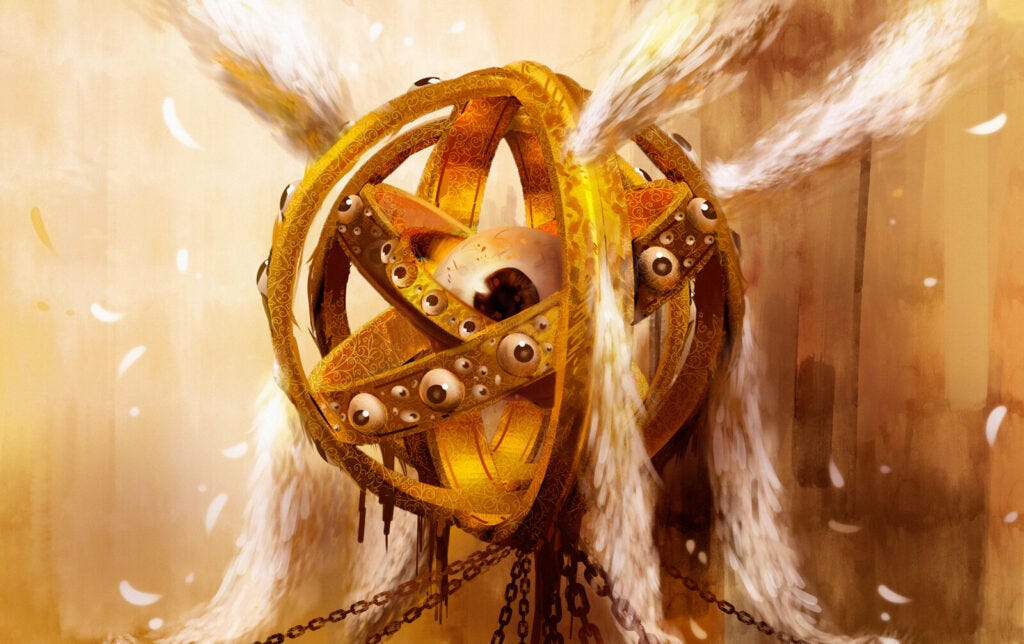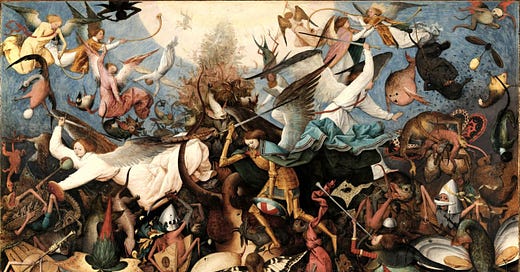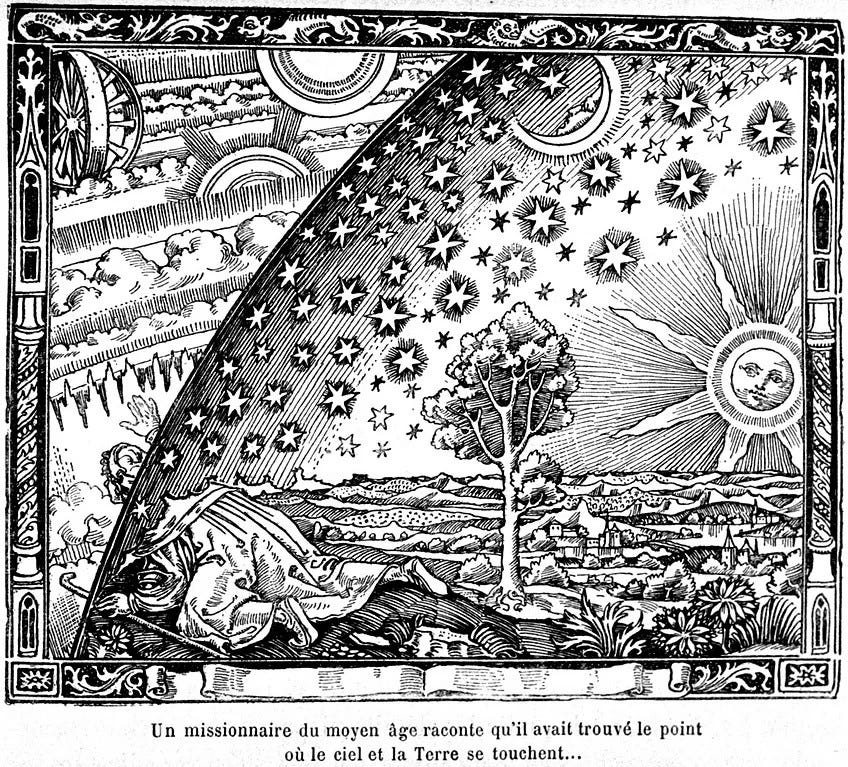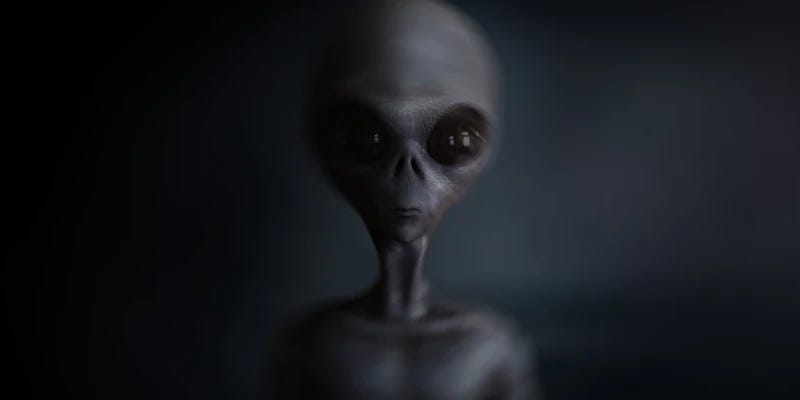The following is excerpted, adapted, and expanded from chapter four of my longform essay, “What Reaches Back”, written in response to a public conversation between Drs. and Michael Levin about panpsychism and the nature of mind.
The panpsychist model of Being is a communicative model. As intelligent, conscious entities, we are in constant conversation with “lower” (less intelligent, less aware, more bounded) conscious entities within range. These include the intellects that govern the cells in our own bodies, and perhaps even the molecules and atoms.
In communicating with these smaller consciousnesses, we berate and cajole, blackmail and bribe, barter and sweettalk them into collaborating with our plans. In other words, we do everything we can to persuade these entities to align with us, and help us achieve our goals. But the same might be said of other forms of highly intelligent entities within our normal sensory range of perception and environment, which try to persuade us to help them achieve their own. These are usually other people, but they could also be lower animal minds, persuading us to pet or feed them.
A question we might ask ourselves here: Could there also be higher minds than humans, trying to persuade us into alignment with their own projects and goals?
(starting at 10:01)
Levin: And so, we're working on some things to look at. What does that synchronicity — another way you to put it, this Library Angel phenomenon — actually look like? You're working on some problem, you're walking through a library, this book falls down. Oh look, there's the [solution].
So what does that look like all the way down? What does that look like on the molecular level? What could we could we say, in that there are ways in which the the solution to your problem — or your binding partner in the case of chemistry, or some other things in AI — are attracting you as much as you're searching for them? These are very early days, but that's that's some stuff we're working on.
McGilchrist: That's fascinating, and for me expresses a very important point about existence, full stop. Which is that everything — everything — is relational. The idea that there are just these things, and then either we find they have relations or we make the relations between them, is again this very reductive view that I associate with… the way the left hemisphere works. Whereas I think the idea that things are in a kind of partnership — in other words, that there is “interdependence”, to use this rather wonderful word which is the title of Kriti Sharma’s book on the relationship between an organism and its environment — not that they just interact serially.
The organism affects the environment, the environment affects the organism, but they literally cocreate one another. So they're coming into being together. Now you could apply that view to the idea of the solution arriving much faster you think. Reaching out to the problem [when] the problem is really a manifestation of a potential solution, and the solution is the manifestation of a potential problem, and they come together. It is extraordinary how these things do do appear
There’s a thorny domain problem here. When we perceive a smaller organism’s environment, it is bound by one or more functional walls, beyond which it cannot survive (or at least, not for long). If it’s a cell, that wall might be the envelope of the animal’s skin. If it’s an animal, it might be one or the other side of the firmament (e.g. the ocean depths for most terrestrials, the land for most aquatics).
These boundaries aren’t necessarily static or unscalable (e.g. the Van Allen radiation belts), but what they seem to share in common is that they limit awareness upwards/outwards in the chain of observation. It may be that a cell is minimally aware of other cells and even organs in its domain, but unaware of the higher animal domain that binds it. At the very least, we’d expect a cell with such awareness to be a “creative genius” of its class.
To stick with the panpsychist view, let’s imagine ourselves and other living creatures as cells in some sort of “body” (operational manifold). That larger/higher domain must also consist of boundaries in various states of stability and strength, but perhaps completely incomprehensible to most of its inhabitants.
If we can observe, analyze and interact with smaller domains within and around us, why couldn’t the inhabitants of higher-bounded domains do the same? What if the “Library Angel” is not a mere metaphor, but rather a genuine attempt to describe such interactions?
But before we look upwards — or outwards — we should consolidate just who or what we might be looking for. One way to do this would be to analyze the phenomenon downstream in the order of intellect within a coherent body, as Dr. Levin has done with his work. In this model, a cell might be convinced to align itself with the organ’s goals, and the organ might align its goals with those of the larger organism. All of these conscious units might be said to be acting intelligently, if not always optimally from the larger organism’s high perspective. If alignment becomes suboptimal, that more intelligent agent might intervene. The monkey scratches its itchy armpits, the tiger licks its wound, the human pays a visit to the doctor, etc.
These nouns — monkey, tiger, human — are the mind-extrapolated characters that we most often treat as the topmost agents in the structure of Being. Panpsychist biology isn't a synecdoche that deforms common sense; the tiger's lung may possess some form of intelligence, but it isn’t on par with the intellect of the tiger. Likewise, the tiger's intellect isn’t on par with the human version. We could perhaps find the world’s smartest tiger and match him against a brain damaged human, but anyone with an ounce of common sense would see through the trick.

When assembling a new language model, I don’t think we can abandon common sense without paying a steep price. It’s the same with words like You and I. They are present in every language, even if only through the language of behavior. We draw sharp category distinctions between You, I, We, and They, without having to think about it. It’s the same when species are concerned. A monkey is not a tiger is not a man, requiring no more proof than our common senses. If someone tries to redraw or erase those boundaries, we know they're up to some funny business.
We have other categories that appear in every language, linked to mind-extrapolated characters that are a bit more controversial. The species they belong to are said to operate at a higher level of intellect and complexity than even the most intelligent human agents. While practically all prior generations of mankind accepted our lower position in the mindspace as a plain fact of existence, even the mention of such beings — or even of a hierarchy of being whatsoever — seems to offend our modern sensibilities.
That group includes most modern religious sensibilities, by the way. After all, have we not been given dominion over the Earth? If we are the Children of God, how could other creatures ever surpass us in complexity of intellect? Nevertheless, these beings and cross-breeds make appearances throughout religious texts and mythological traditions.
If such creatures exist above us in the order of intelligence, we should assume they’d be even be more persuasive in alignment of being than we humans are. While humans can be geniuses at instrumentalizing material in secondary fashion (e.g. tools and techniques), we cannot typically alter structure with our thoughts alone (with the exception of our brain matter). But if we hypothesize a being who exceeds our mental powers in the same way that a man exceeds a tiger, or even as a tiger exceeds one of its own tracheal cells, we might expect a level of material influence that would appear strictly magical to us. It might even be the case that embodiment is more directly designed and implemented by this species, allowing for bodies so novel and plastic that Dr. Levin’s experiments with planarians and tadpoles would look mundane by comparison.
This version of superbiology is similar to the gods and monsters of many pantheistic traditions. The god simulates and instrumentalizes existing patterns, either as a 1:1 representation or in chimeric fashion, but retains qualia of experiential mind that are recognizably human (or superhuman). When Zeus assumes the shape of a white bull to woo Europa, the field of Zeus’s mind isn’t altered, and he retains his powers for directly shaping matter forms. Likewise, the Lernaean Hydra isn’t merely some sad freak born of genetic damage. It is a high-functioning and dangerous faun, well-adapted to its environment and boasting extreme regenerative powers. All that was required was a potentiality for such form, and a mind suitable to instrumentalize it.
In that light, the various shapeshifters, chimeras and other supernatural beings that haunt all artworks would meet the standards of biological organism, but also surpass our own organic limitations. “I think, therefore I am,” becomes a statement about structural form. “Today, I think I am an insect. Tomorrow, a white bull. The next day, a sea serpent. The next day, a swan.”
In this light, minds that can think faster, deeper, more expansively, and more nimbly than our own might constitute a decent definition of the gods, angels, demons, and other supernatural beings that have populated our stories for as long as we’ve been telling them. And because matter is downstream of consciousness, we might expect that their latitude of structural transformation options would be wider than ours — and possibly much, much wider, akin to the difference between an animal and an integrated local cell.
Note that the superbiological domain isn’t necessarily the highest, either. Within this higher — or, at least, more distant — taxonomy, they would constitute a greater level of fractal complexity, while still recognizably rooted in the same Source pattern. But their bodies would still seem quite alien to ours. The similarities might not be much more than the bodies of bronchioalveolar cells are similar to the lung it serves, or a lung’s body similar to the animal it serves. The superbiologic doesn’t even need to conform to a pre-existing pattern in our environmental framework, which is probably why some accounts appear to struggle mightily with physical details.
As I looked at the living creatures, I saw wheels on the ground, one alongside each of the four living creatures. The appearance of the wheels and their work was like unto the colour of a beryl: and they four had one likeness: and their appearance and their work was as it were a wheel in the middle of a wheel. When they went, they went upon their four sides: and they turned not when they went. As for their rings, they were so high that they were dreadful; and their rings were full of eyes round about them four.
Ezekiel 1: 15-18 (KJV)

Their experience of being, situational awareness, sensory detail, memory capacity, and range of action will likely all be more complex and alien as well. With sufficient complexity, we’d have to consider the possibility that their perception of spacetime is extremely different, too.
For example, we don’t measure the lifespan of a paramecium in calendar years, but in number of asexual fissions. A much more complex mind, with an embodiment that isn’t subject to the same forces of entropic decay, might likewise measure our species’ existence by a different metric. For example, their units of measurement might be something akin to opportunities, decision nodes, or even the “narrative beats” of our life stories. We should at least consider the possibility, given how this version of asymmetric interaction aligns with so many myths and legends around the world.
Given our limitations, how would we even begin to assess and describe encounters with such higher minds? What do we risk in trying to model them accurately, and what happens when we make mistakes?
(excerpt from
’s “Minds Greater Than You”)There’s an interesting lesson here. Namely that we can’t understand our betters, our true betters. Their utterances, their actions are a mystery to us, or, since we can’t even grasp that, they seem wrong, pitiful, weak, aggressive, even repulsive.
From all this follows a peculiar conundrum: if we want to advance, how can we learn from those wiser than us if we can’t recognize them, and their words and actions seem erratic or even sinful to us? This is why various esoteric and mainstream religious traditions operate with harsh discipleship and discipline: as an adept, you make a gamble, a leap of faith, and submit to a spiritual master, guru, priest or religious hierarchy completely and unquestioningly. You suspend your critical mind, in recognition that you have no way of understanding a higher mind, and therefore no basis for criticism. To advance, you must trust and pay with giving up parts of your egoic instincts and drives. You willingly submit to authority in the hope that you will learn something down the road that you can’t learn by yourself because your thinking — your whole being — is screwed up, low in development as it is.
Needless to say, this is dangerous business. Abuses of this sort of relationship are legion; countless fake or corrupted religions, cults, mystery schools and so on attest to that. Then again, if the stakes are high, so is the potential reward; there’s nothing free in this universe.
Luc is (maybe) speaking strictly of human minds here. But I think the potential rewards and pitfalls are largely the same; if you’re dealing with a mind so powerful that it doesn’t require a specific embodiment to transact with you, then you better have a well developed trust heuristic.
It might even be able to assemble novel embodiments on the fly, shapeshift at will, as part of a strategy to transact with less complex holons in a language they can understand. For all we know, we even assist them in the design of such novel bodies, via the expectations that we cobble together from the general information space of stories and art.

An analogy might be found in our tabletop simulations and video games, in which players can radically change the shape of their avatars by imagining a new one (typically with assistance from one or more human artists). Organic formation becomes something like a strategic costume change in this model, governed by the creative geniuses of a superspecies who can skip the procedural steps and processes of gradual evolution, the way human creatives can skip straight to the solution in a problem space.
Artists have always observed that such higher order minds and superbiological creatures exist. But they have also observed that these beings, while more powerful than ourselves, don’t constitute the top of the hierarchy either. They still experience events located within some semblance of narrative order, and their ability to transact is still limited by some form of energy scarcity and other rules. We just don’t always agree on what those rules are. Cue holy war.
Or cue implacable skepticism, these days. When such beings are said to transact with humans, the default assumption now is that the human reporter unconsciously imagined or hallucinated the transaction, or that he consciously made the whole thing up, to gain some kind of advantage. I think that’s a valid way to approach this sort of claim; we would need to assume such direct transactions are rare. Otherwise there’d not only be no reason to question such accounts, but to report them at all: “You saw a squirrel in the woods, you say? That makes sense; lots of squirrels live there. Who cares?”
However, to insist that these transactions never occur strikes me as a dangerous form of hubris, and perhaps a failure mode of the Emissary’s method. If we study the accounts with an open mind, their rarity might instead suggest something recognizable and potentially alarming about the nature of this species. For instance, it might call to mind the chameleon or octopus, activating camouflage to hide from beings who mean them harm. But it might also call to mind the tiger’s stripes, the leopard’s spots, the polar bear’s snow-white murder suit. If we are below these creatures in the hierarchy of complex being, might we also constitute their favorite prey?
If such superbiological beings can transact with us in observable spacetime, we might guess expenditures of energy are required. But if energy is equivalent to information, it’s possible that the metabolic process of superbiologics occurs at a level that precedes matter conversion.
If not biological material, what form of energy might such a creature feed on?
(ETA some additional thoughts)
The stills above are taken from the TV show Twin Peaks. Created by David Lynch and Mark Frost, it is a famously “impenetrable” work of creative genius, inspiring countless pages of investigative critique. But one element of the show that is sometimes missed for its frankness and simplicity is the presence of superbiological beings, in the form of good and evil “spirits” (e.g. angels and demons, although they are never explicitly named as such). Both kinds of beings exhibit properties and methods well-established in multiple traditions. For instance, one of the show’s major demons has the ability to take possession of human bodies. Meanwhile, angels like “The Fireman” assume their role of providing the heroes with helpful clues and magical boons.
The demons’ goals are also recognizable, but only if you understand their aligned telos. While a demon may use a human body to commit acts of murder, murder is not an end in itself. The goal is to sow and harvest human misery as a food source (called “garmonbozia” in context of Twin Peaks). We can think of them as a breed of superpsychopaths, who derive not just sadistic pleasure from suffering, but view it as a means of metabolic survival and flourishing. If we imagine a blend between Freddy Krueger and a starving tiger, we might be on the right track.
In both cases, the superbiological being tries to persuade us into alignment with its goals. This typically involves an element of choice, although the layer of mind at which such choices occur isn’t necessarily clear or static. In accounts of full demonic possession (e.g. where the persona and will is entirely replaced) it seems to be the case that the higher human consciousness is circumvented, and the lower wills of the organs and cells are persuaded instead. The result is essentially a complex puppet show, which ebbs and flows as the human consciousness tries to regain control over the lower minds within range.
Here is a question, which
and I explored in a recent podcast: Does demonic possession count as a tactical error? We reached the conclusion that it might be a superbiological version of a mistake that human psychopaths make in evaluating their prey. But it also might be construed as a typical limitation of domain perception.For instance, in diagnosing our own body parts that have fallen out of alignment (“Ow!”), we often don’t know exactly what we’re looking for. Even though we are higher minds, we don’t natively speak the language of our cells. It’s only through careful study and well-developed techne that we can have complex conversations with them. And even then, we often misunderstand and fail (see: the modern pharmaceutical industry). We often don’t quite know what we’re looking at, and misread the causal relationships involved.
I suspect it is the same in the superbiological realm, with beings who fall short of God Almighty. Unlike Him, they do not see the full picture. They can misread the situation, and accidentally reveal information that doesn’t serve their goals. The tiger moves too soon, too aggressively, and temporarily loses its camouflage. Or worse, it conflates one species with another, confuses a more dangerous predator for easy prey. It doesn’t notice the angel standing over the man, helping him to see deeply into the shadows of that more distant domain and resist the demon’s call.
There are greater and lesser species of demon, however. The more intelligent ones will never reveal themselves, until they have fully captured their victims in a web of sins and crimes. They perform their work gently and subtly, employing human proxies to handle most of the visible business.
Thank God for the idiots, whose rake-stepping antics can even bring a foolish sinner like me back onto the path of His light.
The Cat Was Never Found is a reader-supported blog. I don’t publish much paywalled content, so your patronage is very much appreciated.
P.S. If you found any of this valuable but cannot commit to a subscription, consider dropping some change in my tip jar, instead. It will also grant you access to my “Posts” section on the site, which includes some special paywalled Substack content.










This is the greatest piece of writing I have read on Substack thus far. Thank you.
How’s part 2 of your essay on the fear of God coming along, Mark?